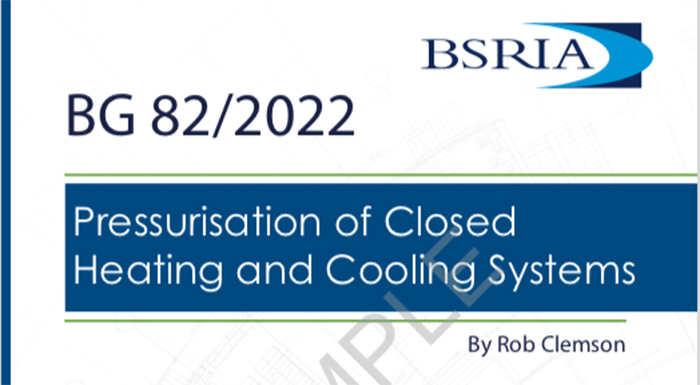Pressurisation of Closed Heating and Cooling Systems (BG 82/2022)
The maintenance of acceptable pressures whilst accommodating thermal expansion is one of the key factors in ensuring continuous and correct functioning of heating and cooling in buildings. Correct pressurisation prevents system failures, thus saving building owners time and cost related to system downtime and repairs.
Contents |
[edit] BSRIA launch
Pressurisation of Closed Heating and Cooling Systems (BG 82/2022)
This guide explains the principles of pressurisation, the different types of equipment used, and the calculation procedures following both British and European standards. The guide has been developed with a steering group of industry experts, following discussions on the importance of pressurisation, in the context of closed heating and cooling systems. Correct pressurisation prevents system failures, thus saving building owners time and cost related to system downtime and repairs.
[edit] Overview
In the context of closed heating and cooling systems, the term pressurisation covers:
- Maintaining system pressure within acceptable limits
- Accommodation of thermal expansion and contraction
- The application of safety devices
It may also include automatic top-up of system water and initial system filling.
[edit] Product details
Published: November 2022
Publisher: BSRIA
Author: Rob Clemson
ISBN: 978-0-86022-796-0
This article appears as "Pressurisation of Closed Heating and Cooling Systems (BG 82/2022)" on the BSRIA knowledge and bookshop website dated November 2022.
--BSRIA
[edit] Related articles on Designing Buildings
- Air handling unit.
- Active pressurisation.
- Boiler markets and the green recovery.
- Building heating systems.
- Building services.
- Cooling plant
- Corrosion in heating and cooling systems.
- Fan coil unit.
- Heat meter.
- Heat pump.
- Heating controls.
- HVAC.
- Radiant heating.
- Thermal comfort.
- Types of domestic heating system.
Featured articles and news
EPC changes for existing buildings
Changes and their context as the new RdSAP methodology comes into use from 15 June.
Skills England publishes Sector skills needs assessments
Priority areas relating to the built environment highlighted and described in brief.
BSRIA HVAC Market Watch - May 2025 Edition
Heat Pump Market Outlook: Policy, Performance & Refrigerant Trends for 2025–2028.
Committing to EDI in construction with CIOB
Built Environment professional bodies deepen commitment to EDI with two new signatories: CIAT and CICES.
Government Grenfell progress report at a glance
Line by line recomendation overview, with links to more details.
An engaging and lively review of his professional life.
Sustainable heating for listed buildings
A problem that needs to be approached intelligently.
50th Golden anniversary ECA Edmundson apprentice award
Deadline for entries has been extended to Friday 27 June, so don't miss out!
CIAT at the London Festival of Architecture
Designing for Everyone: Breaking Barriers in Inclusive Architecture.
Mixed reactions to apprenticeship and skills reform 2025
A 'welcome shift' for some and a 'backwards step' for others.
Licensing construction in the UK
As the latest report and proposal to licence builders reaches Parliament.
Building Safety Alliance golden thread guidance
Extensive excel checklist of information with guidance document freely accessible.
Fair Payment Code and other payment initiatives
For fair and late payments, need to work together to add value.
Pre-planning delivery programmes and delay penalties
Proposed for housebuilders in government reform: Speeding Up Build Out.
High street health: converting a building for healthcare uses
The benefits of health centres acting as new anchor sites in the high street.
The Remarkable Pinwill Sisters: from ‘lady woodcarvers’ to professionals. Book review.
Skills gap and investment returns on apprenticeships
ECA welcomes new reports from JTL Training and The Electrotechnical Skills Partnership.


























Comments
[edit] To make a comment about this article, click 'Add a comment' above. Separate your comments from any existing comments by inserting a horizontal line.